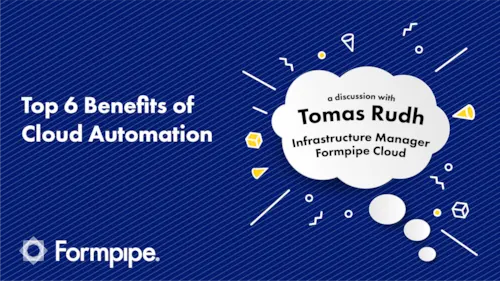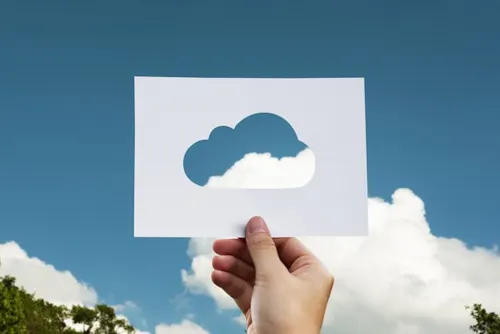We use cookies.
Formpipe uses cookies to improve how the website works for you as a visitor. To change your settings or for more information about cookies, click on 'Settings'.
Cookie Settings.
Formpipe uses cookies to improve how the website works for you as a visitor. Here you can change and see information about what cookies are used. Turn on and off categories and save your choice. To learn more click 'Cookie policy'.
Necessary cookies
These cookies are essential for the website to operate correctly and cannot be disabled without ruining the usability of the website. We delete these cookies when you leave the website, where possible.
| Name | Retention period | Information about the cookie | Disclosure of information to third party |
| ASP.NET_SessionId | Used to maintain an anonymised user session by the server. | 1 session | No. |
| cookie-consent-settings | Used to determine if the user has accepted the cookie consent, contains consent choises | 30 days | No. |
| lidc | To promote data center selection | 1 day | Yes, LinkedIn |
| li_mc | Used as a temporary cache to avoid database lookups for a member's consent for use of non-essential cookies and used for having consent information on the client side to enforce consent on the client side | 2 years | Yes, LinkedIn |
| BIGipServer~EPWS~EPWSWEB103_HTTP_Pool | Determine pool | 1 session | Yes, EPiServer |
Statistics, anonymous data collection
These cookies are used to track our visitors across our website. They can be used to build up a profile of search and/or browsing history for every visitor, or to better understand how the user uses the website so that we can improve it. Identifiable or unique data may be collected. Anonymized data may be shared with third parties.
| Name | Information about the cookie | Retention period | Disclosure of information to third party |
| _fbp | Used by Facebook | 90 days | Yes, Facebook |
| AnalyticsSyncHistory | Used by LinkedIn | 30 days | Yes, LinkedIn |
| bcookie | browser identification | 2 years | Yes, LinkedIn |
| lang | Language preference | 1 session | Yes, LinkedIn |
| li_gc | Used to store guests' consent to the use of cookies for non-essential purposes | 2 Years | Yes, linkedIn |
| lms_analytics | Used to identify LinkedIn Members in the Designated Countries for analytics | 30 days | Yes, LinkedIn |
| _guid | Used to identify a LinkedIn Member for advertising through Google Ads | 30 days | Yes, LinkedIn |
| _ga | Used by Google Analytics to identify a visit. | 2 years | Yes, Google gains access to the information collected by the cookie. |
| _gid | Used by Google Analytics to identify a visit. | 24 hours | Yes, Google gains access to the information collected by the cookie. |
| _gat_gtag_[Property-ID] | Used by Google Analytics to identify if a visitor (web browser) is new or recurrent. | 1 minute | Yes, Google gains access to the information collected by the cookie. |
Marketing, targeted advertisement
These cookies are used by third party to track and collect data to be used in advertisment. They can be used to build up a search and/or browsing history for every visitor. Identifiable or unique data may be collected.
| Name | Information about the cookie | Retention period | Disclosure of information to third party |
| ajn | Used by adnxs for marketing | 90 days | Yes, adnxs |
| uuid2 | Used by adnxs for marketing | 90 days | Yes, adnxs |
| IDE | Used by Google doubelclick | 2 years | Yes, doubleclick |
| _gcl_au | Google adsense | 30 days | Yes, Google |
| msd365mkttr | Dynamics marketing | 2 years | Yes, Microsoft |
| NID | Google ads optimization | 6 months | Yes, Google |
| __Secure-3PAPISID | Builds a profile of website visitor interests | 2 years | Yes, Google |
| __Secure-3PAPISID | Builds a profile of website visitor interests | 2 years | Yes, Google |
| __Secure-3PAPISID | Builds a profile of website visitor interests | 1 year | Yes, Google |
| UserMatchHistory | Sync LinkedIn Ads ID | 30 days | Yes, LinkedIn |
| lms_ads | Used to identify LinkedIn Members off LinkedIn in the Designated Countries for advertising | 30 days | Yes, LinkedIn |
We would love to talk to you. Give us a call, visit us or just send an email.
Support
Whether you're looking for some
assistance or further information
regarding your solution, we're here
to help. Yes, take me there!
Sweden
Headquarters, Stockholm
Formpipe Software AB
Sveavägen 168, Stockholm
Box 231 31, 104 35 Stockholm
SE – Sverige
Tel: +46 8 555 290 60
Email
Linköping
Gasverksgränd 2, 582 22 Linköping
Tel: +46 8 500 072 25
Email
Västerås
Metallverksgatan 6, 721 30 Västerås
Örebro
Engelbrektsgatan 6, 702 12 Örebro
Denmark
Lautrupvang 1
2750 Ballerup
Tel: +45 3325 6555
Email
Germany
Formpipe Lasernet GmbH
THE SQUAIRE 12
Am Flughafen
60549 Frankfurt am Main
Email
UK, Cambridge
First Floor, Block A, Harston Mill,
Cambridge – CB22 7GG
Tel: +44 1223 872747
Email
UK, Nottingham
Unit 1, Isaac Newton Centre
Nottingham Science Park
Nottingham – NG7 2RH
Tel: +44 115 924 8475
Email
USA
Formpipe, inc.
1200 US Highway 22 E Suite 2000
Bridgewater, NJ 08807
Tel : +1 908 200 7937
Email
3 Cloud Trends from 3 Cloud Experts for 2023

While cloud technology has been around for over a decade, its usage has skyrocketed over the past three years. A global pandemic, an economic crisis and the shift to remote working has meant that organisations have sped up cloud adoption drastically. And the cloud’s upward trajectory is only expected to continue. Gartner’s latest projections estimate that end-user spending on public cloud services will total $591.8 billion in sales in 2023, a 20.7% increase from 2022.
The benefits of cloud adoption are endless, ranging from cost savings, to security, flexibility, time savings, and increased collaboration. Moving to a cloud-based way of working is no longer ‘if’ but ‘when’ for the majority of organisations, as its capabilities prove vital for moving forward, especially in an uncertain economy.
As 2022 is now behind us, what are the key cloud trends we can expect to see in 2023? Three of Formpipe’s top cloud experts have given their opinions on what they foresee in the world of cloud computing this year. Read on to find out more.
What trends are driving cloud technology in 2023?
As with the ever-evolving nature of technology, cloud computing is constantly seeing new changes and advancements. Business decisions are shifting in line with factors such as sustainability concerns, a looming pandemic, work-from-home models and the energy crisis. As such, the way we use cloud technology is changing to keep up with new and changing landscapes.
Here, three of Formpipe’s cloud experts have shared their top predictions on what trends will shape cloud technology in 2023.

Tomas Rudh, Cloud Infrastructure Manager
Trend 1: Cloud security
Cybersecurity attacks have gone up by 47%, in part due to vulnerabilities caused by shifting to remote work. When adopting cloud technology on a large scale, this can lead to a number of risks, particularly when you have employees in offsite locations. Issues such as software bugs, human errors and exposed API’s can all lead to a security breach.
With the huge increase in cloud adoption, cyber criminals are more likely to target organisations in the cloud environment. Therefore, cloud security should be a top priority for businesses moving forward.
Tomas Rudh, Formpipe’s Cloud Infrastructure Manager, explains why choosing a reputable cloud provider is paramount when it comes to security.
“When you move to the cloud, you're typically depending on the cloud provider to manage security. So you need to audit and get assurances from those third parties that they are secure. Two ways of assessing this include looking at their security certifications, and their reputation. If they’ve experienced a breach or have a history of not looking after sensitive data, then that’s an indication to steer clear.”
Encryption is also known as one of the most effective components for any cloud security, or broader cybersecurity strategy. This is the process of encoding and transforming data before transferring it to the cloud, to prevent it being read by malicious actors.
“If data is unencrypted over the internet, cyber criminals can listen in on this data, transfer it and, worst case scenario, they can get access to passwords and other sensitive information that could put an organisation at risk” says Tomas. “Encryption shouldn’t be an option, it should be seen as an absolute must for all businesses operating in a cloud environment.”
Finally, getting a security certification such as ISO 27001 can help your organisation stay safe and avoid security threats. ISO 27001 provides a framework which ensures your business has the right tools in place across the three pillars of cyber security: people, processes and technology. Tomas says:
“Certifications such as ISO 27001 can help, as auditors might test things in a way we haven't thought of. And, obviously, to have a sheet of paper to show we are certified by trusted authorities, reassures everyone including clients and customers that we are safe and secure.”

Usama Musthafa, Cloud Infrastructure Engineer
Trend 2: Serverless architecture
Serverless architecture is a software engineering approach that allows developers to build and maintain services without having to manage the underlying infrastructure. The execution model means that developers can focus on writing and deploying code, while their cloud provider runs applications, databases and storage systems.
This approach has a multitude of benefits for cloud-based organisations including easy maintenance, decreased liability, and cost effectiveness.
Usama Musthafa, Formpipe’s Cloud Infrastructure Engineer, shares why he feels serverless architecture will be a key trend for cloud in 2023:
“The reason it's an emerging trend is because it can improve a team’s productivity, and allow them to focus more on core automation and development tasks. Additionally, serverless architecture provides greater scalability and flexibility than traditional methods such as deploying the entire infrastructure on premise or on a public cloud infrastructure like Azure or AWS, for example.”
Sustainability and environmental benefits are also key drivers for implementing serverless architecture. As businesses globally commit to net zero pledges, sustainability efforts will become a top priority in 2023.
“With serverless architecture, you only pay for what you use, which I think helps with the environmental case as well. You don't waste resources on electricity, you can basically just use the resources that you need at that moment. So serverless is often much greener than traditional applications in the cloud” says Usama.
Will serverless architecture continue its uptick next year? Usama believes that emerging technologies will increase the demand for, and use of, serverless tech.
“I think it'll progress really well. I believe a lot more companies will adopt serverless architecture, which means they’ll require less specialised individuals handling server infrastructure and focus more on development. So examples of this include the increased use of containers and orchestration tools and serverless architectures to deploy containerised application service functions. You also have machine learning and AI models being used more using serverless infrastructure.”

Ben Stock, Senior Software Engineer
Trend 3: GitOps
While GitOps is a methodology and not a cloud technology, the standards and frameworks it provides acts as a modern and effective way to manage cloud-native systems. GitOps was first pioneered in 2017, and with Microsoft purchasing GitHub - a cloud-based Git repository - its usage will only continue to rise.
GitOps leverages a policy-as–code approach to define and control each layer of an application stack - from infrastructure, to networking, and application code.
Ben Stock, Formpipe’s Senior Software Engineer, explains why GitOps is becoming more and more relevant in a cloud-driven landscape.
“With the upscaling in cloud adoption, comes increased overheads for maintenance and deployment of the infrastructure on your cloud platform. So infrastructure-as-a-code (IaC) is absolutely essential to reducing some of that overhead. However, you really want some level of standards and best practices to define how you manage IaC and how you actually deploy it. So GitOps provides foundational principles, best practices, standards, and guidance in terms of how to implement that and maintain it.”
The rise in remote working and the subsequent rise in cloud adoption has only increased the need for GitOps integration to maximise collaboration and productivity. While DevOps practices have been around for quite some time, GitOps was established as a DevOps best practice tool for improving infrastructure automation. Ben explains the relevance of this today:
“After that initial cloud adoption phase, companies begin realigning their focus and think, ‘We know how to work on the cloud and we're comfortable with it, but now we need to rein in the cost of it and streamline practices, how do we best do that?' So, rather than having people spinning up infrastructure manually and then being left because no one's aware of it, losing control and visibility. Codifying those processes into a GitOps pipeline makes it much easier to observe and think about your presence in the cloud.”
With Microsoft’s purchase of GitHub, it’s likely that in 2023 and beyond, we will see more organisations integrate Git into their digital infrastructure.
“If you look at the Microsoft purchase of GitHub, this means Microsoft will move towards really integrating Git and Git workflows directly into their cloud platform and alter the tooling and services to treat Git as a first class. As a result, organisations which use Microsoft products such as Azure, will also be adopting and integrating GitOps.”
Optimise your cloud adoption & cloud technology strategy with Formpipe
Are you interested in learning how emerging cloud technologies could benefit your business? Embrace the cloud and reduce the cost with Formpipe Cloud. Chat to a member of our team about Formpipe Cloud and request a demo below.



